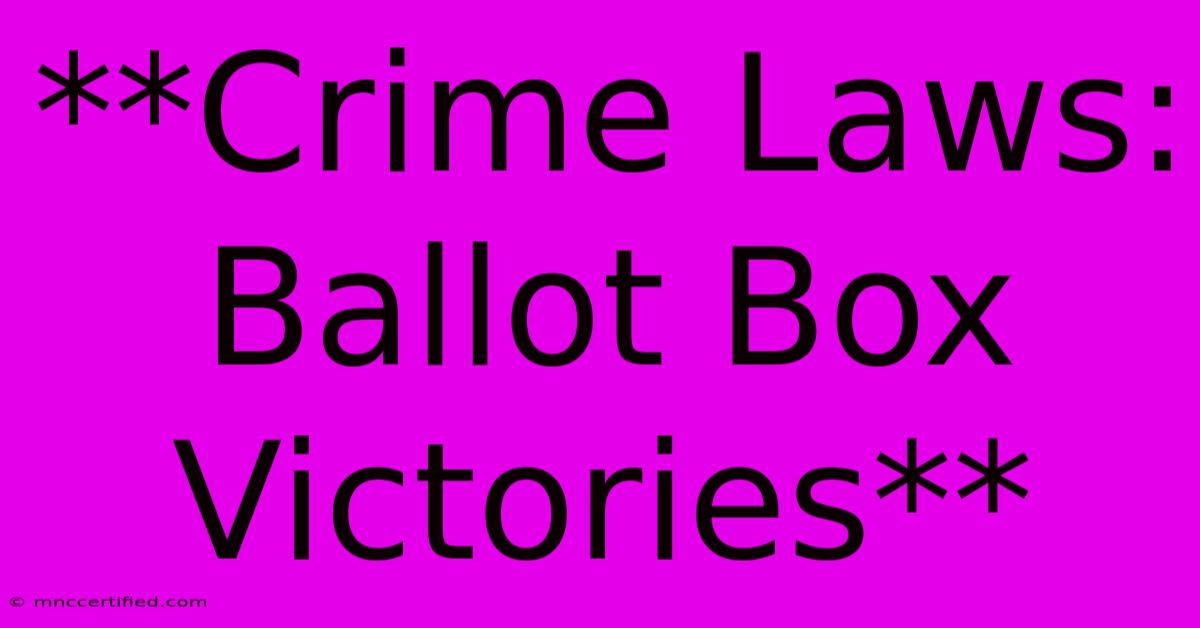**Crime Laws: Ballot Box Victories**

Table of Contents
Crime Laws: Ballot Box Victories
The American legal landscape is constantly evolving, and nowhere is this more evident than in the realm of criminal justice. In recent years, a wave of criminal justice reforms has swept the nation, largely driven by voter initiatives that have directly challenged traditional approaches to crime and punishment. This trend, often referred to as "ballot box victories," reflects a growing public awareness of the flaws in the current system and a demand for change.
The Rise of Criminal Justice Reform Initiatives
The impetus for this movement stems from a confluence of factors. Public perception of the criminal justice system has been shifting, with concerns rising over mass incarceration, racial disparities in sentencing, and the cost of maintaining vast prison populations. The Black Lives Matter movement has amplified these concerns, sparking broader conversations about systemic racism and police brutality. This has led to a surge in voter initiatives aimed at addressing these issues.
Key Examples of Ballot Box Victories
Across the country, voters have successfully passed numerous initiatives that have significantly impacted criminal justice policies:
- Sentencing Reform: Many states have passed measures to reduce mandatory minimum sentences, expand eligibility for parole, and allow for early release for non-violent offenders. These reforms aim to address overcrowding and reduce the financial burden on taxpayers.
- Drug Policy: Several states have decriminalized or legalized marijuana, reducing the number of people incarcerated for drug offenses. This trend reflects a growing recognition that the "war on drugs" has been ineffective and disproportionately impacted minority communities.
- Police Accountability: Initiatives to strengthen oversight of law enforcement agencies, create independent investigations of police misconduct, and implement body cameras have gained significant traction. These measures seek to enhance transparency and accountability within police departments.
- Restorative Justice: Initiatives promoting alternative sentencing options, such as community service, restorative justice programs, and diversion programs, have gained momentum. These approaches prioritize rehabilitation and reintegration into society, rather than solely focusing on punishment.
The Impact of Ballot Box Victories
These reforms have had a demonstrable impact:
- Reduced Incarceration Rates: States with comprehensive criminal justice reforms have seen significant decreases in their prison populations.
- Increased Public Safety: Some studies suggest that these reforms have not led to an increase in crime rates, contrary to the claims of some opponents.
- Enhanced Equity: By addressing racial disparities in sentencing and policing, these reforms have helped to promote a more equitable justice system.
Challenges and Considerations
While ballot box victories have brought about positive changes, they also present challenges:
- Implementation and Enforcement: Ensuring that these reforms are implemented effectively and enforced consistently is crucial.
- Political Opposition: Resistance from law enforcement agencies and conservative lawmakers can hinder progress.
- Long-Term Impact: The long-term impact of these reforms requires continued monitoring and evaluation.
The Future of Criminal Justice Reform
The trend of ballot box victories is likely to continue as public pressure for criminal justice reform mounts. Voters are increasingly demanding policies that are fair, equitable, and prioritize rehabilitation over punishment. This movement represents a shift in how we approach crime and punishment, with the public playing a more active role in shaping criminal justice policy.
Keywords: Criminal justice reform, ballot box victories, sentencing reform, drug policy, police accountability, restorative justice, mass incarceration, racial disparities, public safety, equity, implementation, enforcement, political opposition, long-term impact.

Thank you for visiting our website wich cover about **Crime Laws: Ballot Box Victories**. We hope the information provided has been useful to you. Feel free to contact us if you have any questions or need further assistance. See you next time and dont miss to bookmark.
Featured Posts
-
Paria Fuel Trading Company Limited Reviews
Nov 07, 2024
-
Empowering The Investment Foundation Grant
Nov 07, 2024
-
Levis Heir Tops Sf Mayoral Polls
Nov 07, 2024
-
New York Man Charged With Supporting Terrorism
Nov 07, 2024
-
Barcelona News 6th November 2024 Updates
Nov 07, 2024